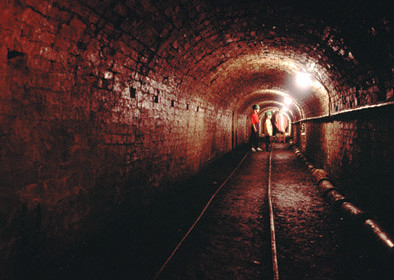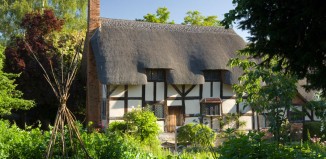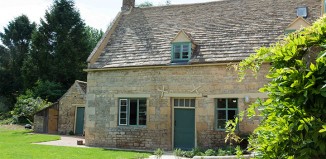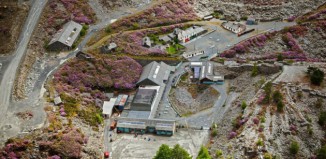Industrial icons at Ironbridge Gorge
Coalbrookdale Museum of Iron
The story of Ironbridge begins with Abraham Darby I, an industrial pioneer who smelted iron in a furnace on this spot in 1709. From this revolutionary discovery, mass industrialisation was born leading to fame and fortune for England’s productive heartland. Housed within a 19th-century warehouse, the Museum of Iron is perhaps the star of the World Heritage Site, as the place where it all began. It was through Darby’s breakthrough with coke that the ironworks were able to modify their uses for cast iron, building progressive new items such as the first iron railway lines and steam locomotive. The museum highlights the growth of Ironbridge, its achievements and high achievers, including John ‘Iron-Mad’ Wilkinson who created the first iron boat. Find out how workers adapted to change as fierce competition in industry threatened the local livelihood, and how an excellent reputation for producing fine art casting and architectural ironwork was earned. At the front of the museum visitors can tour the original Old Furnace used by Darby, which is surrounded by the brick ruins of a once great factory building.
Museum of the Gorge
With the River Severn on its doorstep, this beautiful building is a visual delight inside and out. A film documents the history of the Gorge, while interactive computers help bring the past to life. Here too is a 40ft model of the valley, where the date is forever 12 August 1796, the time of a royal visit from the Prince and Princess of Orange. Look closely: a royal carriage can be seen crossing the magnificent Iron Bridge while elsewhere it’s business as usual for the workers seen labouring in a coal mine or operating heavy machinery. See for yourself some of the types of items produced at the Gorge and explore the story of the area’s rise to World Heritage Site status. Film footage documents the fragility of the Gorge and perils of life in an area so heavily mined. Flooding combined with subsidence sent many homes and streets keeling over in the 1950s; the instability of the ground caused by the centuries of mining means that preservation work must continue to prevent further catastrophe.
Blists Hill Victorian Town
Celebrating its 40th anniversary in 2013, this recreated 52-acre Victorian town offers a snapshot of life through the sounds, smells and sights typical of the era. Compare and contrast the olde-worlde high street with that of present day and witness traditional skills in action at the town’s essential businesses: the printers, chandlers and decorative plasterers. To help visitors acclimatise to the step back in time, a landmark exhibition centre introduces the realities of life during the peak of Ironbridge’s industrial heyday, revealing why the town was so important to industry as a whole. Explore the authentic delights of Canal Street with its wonderful array of stores, among them a traditional sweet shop, a drapers and outfitters. Shopkeepers are ready to help you part with your hard earned shillings and pence, (exchanged at the Victorian bank on entering the town). More than just a novelty, this retail experience has an educational element too, offering insight into age-old remedies at the pharmacy, and traditional retailing. Peek inside the cottage home of a typical housewife, and try on period costume at the town’s photography studio. In the summer months a Victorian fairground is in operation, or you may prefer to ride the 1920s-style clay mine railway into the ‘deep’ to discover the daily hazards faced by miners.
Enginuity
This interactive museum is responsible for firing the imagination and sparking more than a passing interest in science and logic. Designed with families in mind Enginuity challenges visitors to learn through hands-on activities, testing mind and muscle with games and problem-solving in a fun environment. Ever wondered how the world’s tallest towers survive the motion of an earthquake? Build yourself an earthquake- proof tower. Puzzled by the science behind the X-ray? Test one out for yourself and see familiar every-day objects in a whole new light. In the school holidays there are a range of workshops and shows to delight younger visitors, and all can test their skills and co-ordination and pit their wits against the machines, discovering the nuts and bolts of engineering and the genius behind the Ironbridge story.
Coalport China Museum
To gauge how the landscape of Ironbridge Gorge once looked, pay a visit to this red-bricked china factory, home to National Collections of Coalport and Caughley china. Today the factory is an iconic piece of built heritage, its towering bottle kilns once ubiquitous across the region, now two of the few remaining in the country. A hive of activity since 1796 the Coalport China Factory was established by John Rose who had gained work experience in the tile factory further along the Severn at Jackfield. Rose built Coalport into a prestigious company, which won many prizes on the world’s stage, including at the 1851 Great Exhibition in London. The factory closed in 1926 yet its store of exquisite china, which include pieces made specifically for exhibitions and coronations, alongside table and decorative wares, was eventually revealed to the public shortly afterwards in 1976. Don’t miss the Northumberland Vase – the largest piece of Coalport China ever produced, and learn the names for the different styles of tea cup. So delicate and vibrant, the collections illustrate why Coalport became an internationally sought-after brand. Visitors can tour the workshops and see demonstrations of items being made, albeit on a smaller scale than a century ago, or may learn a new skill at a clay modelling or china painting class.
Jackfield Tile Museum
During the 19th century Ironbridge enjoyed a second spell of success owing to the rising trend in fine furnishings. The unassuming village of Jackfield was cast in the spotlight thanks to the Craven Dunnill tile factory. As the wealthy craved luxury for themselves and their homes, the demand for decorated tiles raised this local factory into a world leader – the skilled workforce the envy of competitors. Produced from clay sourced in the Gorge, Jackfield tiles were sent to all four corners of the globe, appearing inside Russian palaces, grand colonial buildings, private houses, even public toilets! Housed inside the original factory, this museum follows the story of the humble ceramic, and how it helped raise the profile of Ironbridge when its iron production heyday was over. Although mass production ceased here in 1969, tiles are still manufactured on a commercial scale, an enterprise reborn in the last 25 years. Many careworn and damaged tiles created over a century ago are now in need of repair or replacement – and it is Jackfield to which these return to be restored or copied. Those who assume that the appeal of a tile museum may be limited are in for a pleasant surprise. Five galleries illustrate their versatility and beauty, the trends that came and went, while room settings suggest creative product placement. A walk through a replica of Covent Garden tube station, into a church, past a completely tiled pub bar, and then a butcher’s shop combine for an extraordinary experience.
Darby Houses
With views extending across the Gorge, the two Darby Houses at the top of Ironbridge town provided lodging for generations of the Darby family. The impressive brick Dale House was built around 1715 by Abraham Darby I. He died before the house was completed, but in his stead it was taken over by Richard Ford, the new manager of the Works at Coalbrookdale. Ford lived there with his wife until neighbouring Rosehill House was built for the couple. Many famous visitors came and went during the Darby ownership, including the Lloyds and the Cadburys – household names still today. While Darby III pored over plans for the new Iron Bridge in his Study, wife Rebecca would have been busy raising their young family. Visitors can tour the ground floor rooms of Dale House and reflect on the events of everyday family life that may have transpired. Rosehill, next door, was also a Darby home for a period, where visitors can experience a little more of the Quaker ironmasters. Restored to reflect life during the 1850s, the house contains the original furniture and personal items belonging to the family. See what would have been on the menu in the kitchen, or dodge the servants’ domain and sample life as a Darby upstairs in the costume room, where swathes of fine clothing can be tried on for size. Although Quaker principals frown upon vanity, the Darby household accounts show that the family enjoyed many comforts, indulging in little luxuries from wine and chocolate to fashionable accessories.
The Iron Bridge & Tollhouse
The world’s first cast iron bridge that spans the River Severn still delights the sightseer as it did for the first tourists in the 18th century. A symbol of Britain’s industrial prowess the famous bridge opened on New Year’s Day in 1781 to much celebration, with visitors charged half a penny to cross. It provided a vital easy-access transport link though local ferryman whose livelihoods depended upon river traffic inevitably found themselves badly hit. At an exhibition held in the original Tollhouse, visitors can discover the story behind the bridge’s construction – the controversy, and the expense. Abraham Darby III oversaw the construction but credit must be paid to its designer Thomas Farnells Pritchard, a Shrewsbury architect who never lived to see his idea realised. There’s no fee today to cross this World Heritage icon, just priceless views down river.
Tar Tunnel
Nowhere else does the reality of local industry become clear than at the Tar Tunnel, a subterranean feat of engineering with a lasting legacy. It was here in 1787 that a team of miners struck upon a spring of natural bitumen, a substance still seen oozing from the brick walls of the tunnel which was originally designed to link the mines of Blists Hill with the Shropshire Canal. Used in Victorian times to make rheumatics remedies among other useful items, bitumen was a valuable commodity, and an unexpected find within the Gorge. Eerie as the experience is of descending into the seemingly endless passageway, this is a sure winner with families, where younger visitors enjoy the novelty of donning a hard hat and venturing underground. Some way down the tunnel, recesses in the brickwork reveal pools of the stagnant dark liquid, the walls trickling with more of the same. Guided tours here are not necessary, and visitors may come and go into the cool passageway as they please. For visitors the way ends at a gate beyond which the light fades into the abyss.
Broseley Pipeworks
Positioned a little way off the beaten track in the pretty town of Broseley, this time capsule of a museum marks a period of history when pipe-smoking was considered the height of fashion. An important addition to the Ironbridge story, this small factory was one of several similar local manufacturers, exporting millions of clay pipes worldwide. Abandoned in the 1950s, the dust may have settled on this heritage attraction, but its future was secured in 1996 when it took its place alongside the nine other Gorge museums. Visitors can see the tools of the trade lying on the benches just as they were left. Upstairs an exhibition space sets the context of factory life, the products and the popularity of pipe-smoking, with gentlemen shown puffing away on long-stemmed Churchwarden and Dutch Long Straw pipes. Follow the story of life on the ‘factory floor’ through a film which captures two of the last ever works’ employees. The traditional techniques used to create each product involved inserting a wire down the length of the pipe stem – no easy feat; the firing process also involved stringent quality checking. Pipe-making demonstrations are occasionally held in the workshops, an insight into an incredible, if dying, art.







